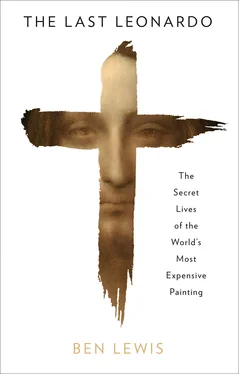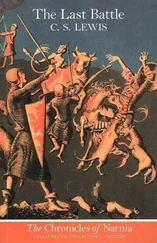In 1506 Leonardo returned to Milan, lured there by its new French rulers, leaving the Battle unfinished, much to the fury of the Florentine town council. In Milan he continued to work on paintings designed or begun in Florence, the Virgin and Child with St Anne and the Madonna of the Yarnwinder among them, although the latter may have been partly executed by assistants. Here he and his assistants probably also finished painting the second version of the Virgin of the Rocks .
The Salvator Mundi was probably begun in this period, possibly for a client from the French court. The painting compresses into its modest format a summation of many, but not all, of the techniques, themes and passions of Leonardo’s oeuvre. His Christ is not like the bright and youthful Jesuses of Raphael, or the strong athletic ones of Michelangelo. He seems a level above such mortal and physical attributes. He floats towards the onlooker like a mystical vision. He transcends time, harking back to the images of a blessing Christ that are found in early Christian catacombs and on the mosaic ceilings of Byzantine churches, but upgraded with a Renaissance makeover that is both realist and idealising. The Salvator’s eyes, eroded as they undoubtedly are, seem to look straight through us, with a gaze as piercing as it is ethereal. Christ’s expression hovers, in that Leonardesque way, between a range of contrasting emotions: serene, placid, wise, resigned, resolute, or implacable and unmoved. On the almost imperceptibly upturned corners of Christ’s lips, damaged as they are, is the slightest trace of a smile. The facial typology of the Son of God seems eerily modern, like those of the Nazarenes or Romantic painters, evidence of the realism and originality of Leonardo’s portraiture.
Leonardo is known for the intricate and precise way he painted hair, so different from the patterned and schematic rendering of his Renaissance contemporaries. In the Salvator , Christ’s long curls glisten with highlights of varying intensity as they catch the light. Amidst the best-preserved strands on the right you will find a double helix, a shape that we find in Leonardo’s drawings of coiled ropes, machines and waterfalls. In his notebooks he wrote of the similarities between the way hair fell and water flowed. There were ‘two motions, of which one responds to the weight of the strands of hair and the other to the direction of the curls; thus the water makes turning eddies, which in part respond to the impetus of the principal current, while the other responds to the incidental motion of deflection’.
These curls may also be carnal. Leonardo’s notebooks contain sketches of curly-haired boys, which are often said to be portraits of his teenage assistant and almost certainly his lover, Gian Giacomo Caprotti da Oreno, whom Leonardo nicknamed Salai, or ‘mischievous one’. In April 1476, a week before his twenty-fourth birthday, Leonardo was arrested by the zealous Florentine vice squad, which patrolled the city streets at night. The accusation was of sodomy with a male prostitute, though the artist was acquitted.
Along the edges of Christ’s garment runs filigree embroidery in golden thread, forming a geometric pattern of knots, sparkling like his hair with reflected light. Leonardo was fascinated by knots, in which his passions for mathematics, geometry and art intersected. He copied and owned the knot patterns of artists, and he also invented his own, far more intricate, ones. Prints of his ‘Vincian knots’ were sold across Europe. Vasari remarked how Leonardo would ‘waste his time in drawing knots of cords, made according to an order, that from one end all the rest might follow till the other, so as to fill a round’. In fact, mathematicians from the University of California analysed Leonardo’s knots a few years ago and found that they were made up of several broken strands, not a single one. Where necessary illusion trumped science in Leonardo’s art.4
The hands and the orb provide further evidence of Leonardo’s keen observation, obsession with detail and willingness to replace the tiringly conventional with the marvellously real. The orb held by the Salvator Mundi was commonly depicted in European Renaissance paintings as brass or bronze, sometimes with a cross above it. Sometimes it was painted as a globe of the earth. In some northern European paintings it is transparent, and within it you may see an unforgiving biblical landscape. Leonardo, however, has painted his as a large, solid rock crystal.† Despite the severe damage this part of the Salvator Mundi has suffered, you can see tiny defects in the orb, known as ‘inclusions’, and air bubbles, each exactingly painted with a dark ring of shadow and a dab of white highlight. Leonardo has added more careful highlights around the fingertips, as if lit by ‘lustre’, as he called bounced light, here reflected off the crystal orb.
Meanwhile, the Salvator’s other hand, raised in blessing, displays a balletic grace and solid volume. It is painted with a faultless foreshortening (a kind of perspective for objects and bodies, when seen front-on) so that it seems to project itself out of the picture towards us. Leonardo has added soft trails of lead white paint along the edges of the fingers, in the creases of the palm, and a dab at the bottom of the thumb, suggesting the softest of broken light from the upper left. Equally, veils of shadow of subtly varying darkness are painted on the parts of the hand facing away from the light, like the third knuckles of the bent fingers. The thumb curves inwards – previously rare in paintings of this type – so that the entire gesture forms an elegantly elongated pyramid, a geometric form Leonardo often used for his compositions of figures.
All these elements cohere in the sfumato style in which the painting is executed. While Leonardo’s peers favoured bright colours and strong lines, Leonardo, a maverick within the Renaissance avant-garde, took painting in the opposite direction towards tonality, building up from dark undercoats to light highlights. Raphael, Michelangelo, Perugino, Piero della Francesca and other Renaissance masters painted scenes that were flooded with light. Their saints, temples and porticos have bright hues. They painted lighter colours on first, in general, and then modelled the figures and architecture with darker shades. But Leonardo worked the other way round. The Salvator is painted up from gloomy underlayers of dark vermilion and black paint. Areas of light are built up from this darkness in thin, transparent layers of very carefully graduated oil-based mixtures, known as glazes. Leonardo advised: ‘Paint so that a smoky finish can be seen, rather than contours and profiles that are distinct and crude.’
However, the sfumato which we admire in Leonardo’s paintings today is never only the work of the Renaissance master. Part of the effect derives from the decay of the art. Leonardo’s fresco paintings, The Last Supper and The Battle of Anghiari , fell apart in his own lifetime because he tried to find a way to paint with oils on plaster; the paint did not stick. In other paintings, most famously the Mona Lisa , the colours have faded and the varnishes darkened. Restorers dare not clean the painting, lest the general public not recognise the work of art which emerges from underneath. The St Jerome once had the saint’s head cut out, and it was only glued back in decades later. Of all Leonardo’s paintings, the Salvator is, relative to its size and regarding the most important areas of the work, the most damaged of them all. Leonardo’s paintings often carry the enhanced atmosphere of an ancient ruin, a work of genius placed slightly beyond reach by the ravages of time. The texture itself prompts a spiritual reflection on the transitory nature of material things, combined with an irresolvable yearning for something lost forever.
Читать дальше












